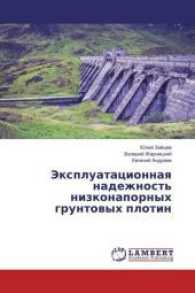- ホーム
- > 洋書
- > 英文書
- > Politics / International Relations
Full Description
In the merciless arena of life, we are all subject to the law of the jungle, to ruthless competition and the survival of the fittest - such is the myth that has given rise to a society that has become toxic for our planet and for our and future generations.
But today the lines are shifting. A growing number of new movements and thinkers are challenging this skewed view of the world and reviving words such as 'altruism', 'cooperation', 'kindness' and 'solidarity'. A close look at the wide spectrum of living beings reveals that, at all times and in all places, animals, plants, microorganisms and human beings have practised different forms of mutual aid. And those which survive difficult conditions best are not necessarily the strongest, but those which help each other the most.
Pablo Servigne and Gauthier Chapelle explore a vast, forgotten continent of mutual aid in order to discover the mechanisms of this 'other law of the jungle'. In so doing, they provide a more rounded view of the world of living things and give us some of the conceptual tools we need to move beyond the vicious circle of competition and self-destruction that is leading our civilization to the verge of collapse.
Contents
Acknowledgements
Foreword by Alain Caillé
Introduction. The age of mutual aid
The law of the jungle
A potentially fatal paralysis
The emergence of another law of the jungle
The construction site of the new century
Chapter One. The history of a forgetting
Everywhere, all the time, and in every colour
Among one's peers
Between distant cousins
Between dissimilar organizations
Our most distant ancestors, champions of mutual aid in all categories
All the colours of 'symbiodiversity'
We are an inextricable bundle of interdependencies
Setting the record straight
Why society hasn't seen it - a story of myths
Kropotkin, the anarchist prince swimming against the tide
Our blinkered society
Why science didn't see it - a history of genes
Before the 1970s
The life, death and rebirth of sociobiology, 1970-2000
The renaissance of the 2000s
Chapter Two. Spontaneous mutual aid
Contrary to popular belief...
Where does Homo œconomicus live?
What emerges in a crisis situation
What emerges from stress and the unknown
How are we to explain these automatisms?
The end of simplistic models
A malleable automatism
Chapter 3. Group mechanisms
The hard core of mutual aid: reciprocity
The obligation to give back
The roots of reciprocity
The transition to the group: extended reciprocity
Reputation (indirect reciprocity)
Rewards and punishments (enhanced reciprocity)
Very large groups: invisible reciprocity
Social norms
Institutions
Chapter Four. The spirit of the group
A magical moment: when the group becomes one
The sense of security
The sense of equality
The sense of trust
The birth of a superorganism
Towards universal principles?
The 'fundamentals': putting them into practice
The principles of good governance
Mutual aid taken to the extreme
The dissolution of the self
Collective ecstasy
Group closure
A tragic moment: when mutual aid collapses
Chapter Five. Beyond the group
The big bad wolf principle
Competition with other groups
A hostile environment
Reaching a common goal
Can groups provide mutual aid to each other?
Overcoming competition between groups
The same mechanisms as at the lower level
A limit on size?
The opportunity of global disasters
Chapter Six. Since the dawn of time
The evolution of human mutual aid
Associating to survive
A band of immature primates
The evolution of mutual aid between peers
'There is strength in unity': the power of group selection
'Winter is coming': the power of the hostile environment
Other evolutionary forces
The evolution of mutual aid between species
Needing the other...
... sometimes it's mutual...
... and eventually you can't do without them
Again and again the hostile environment
An endless source of innovation
Mutual aid calls for mutual aid
Transforming yourself in contact with others
Taking it to the next level
How mutual aid changed the face of the world
Conclusion. The new face of mutual aid
Much more than just a law of the jungle
The main principles of mutual aid
Towards a new vision of mutual aid
Epilogue. For which world?
Are we going to kill each other?
Towards another mythology
Beyond humankind
Appendix. On the 'new sociobiology'
An earthquake in the land of sociobiology
The secret had to lie in the genes
The slow betrayal of the founding father
The power of one man
The various evolutionary forces behind mutual aid
The origins of sociobiology: kinship selection and reciprocal altruism
The discovery of other paths: indirect reciprocity and spatial selection
Towards a more open and complex sociobiology
Notes






